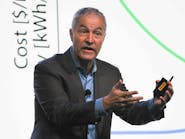The dawn of smart, distributed water treatment
Are our water systems 30 years from now going to look like our water systems 30 years ago? Peter Fiske, executive director, National Alliance for Water Innovation (NAWI), a Department of Energy (DOE)-sponsored program, doesn’t think so. In fact, he told the audience on the final day of YNOW2024, twentieth-century water systems that are linear in nature are reaching the end of their useful lives.
“Many of the pipes under cities are 100 years old, and natural water systems are under stress from the effects of climate change,” he said. In addition, he pointed to inefficient wastewater systems where purified drinking water is used for gray water uses, such as flushing toilets.
Fiske is quick to praise those systems for bringing better health and lifespans to humans over the past century. “We doubled the life expectancy in the U.S. because of the advancement of safe, reliable drinking water,” he said. But the big infrastructure cannot meet the world’s water needs in the future, mainly because climate change and population growth have changed the playing field.
That’s why his organization was created to work on novel water treatment concepts and demonstrate new systems. Fiske was adamant that process controls, fault detection and automation play a big part in what those water systems will become over the next couple of decades.
The systems will be smaller, localized and largely autonomous. NAWI’s goal is to enable cost-effective (small-scale) distributed water treatment and reuse, and it needs control technology to help get it there. The DOE has been pleased with the effort so far and renewed NAWI’s sponsorship for another five years.
Opportunities and implications
Fiske is confident that the transition to decentralized water treatment reuse is possible because such efforts have already been proven successful. He said the transition of water mirrors the energy transition, starting with the distributed model of delivery—often right in the homes themselves—much like solar panels on a roof.
Another key to breaking away from the big infrastructure of water is to move to a manufactured model for products in and near homes versus custom-designed treatment facilities that may be only one to a city and have long lead times while contributing to carbon emissions. “The dominant carbon emissions are the result of moving water to reach customers,” he said.
The practical implications of distributed water treatment and local reuse likely struck a chord with Fiske’s audience at YNOW2024.
“We cannot run thousands of small-scale treatment systems like we run our current treatment plants,” he said.
Instead, future systems will rely on automation technology, particularly to enable autonomous operation, provide fault protection and predictive maintenance monitoring, and add resilience with more intermittent operation and power grid flexibility. Fiske expects new systems to utilize machine learning tools to enable autonomy and optimization at scale.
He also offered that the modular design of these systems will allow them to be mass-manufactured and delivered to consumers, thereby cutting the costs per unit. In addition, they’ll be electrified, making a shift from chemical-based water treatment to electrical-based systems.
The future is arriving already
Fiske came to the stage armed with plenty of examples of the work being done to plant the seeds of manufacturing of these novel water systems. One example of an advanced treatment system, built by the University of Texas-El Paso (UTEP), uses electrodialysis instead of reverse osmosis to treat water. “It means we can take a complex brine into this system and sort the ions, so rather than just purifying water, this facility will produce water and the treatment chemicals to treat the water at the same time.”
A second research project by NAWI that Fiske highlighted is a direct potable reuse (DPR) trailer, which is an example of one of the novel concepts that is coming to our water systems. Rather than throwing wastewater away it repurifies the water, often to a higher standard than normal drinking water. Developed by the Colorado School of Mines, the trailer also functions as a mobile laboratory.
“It produces an enormous volume of data,” Fiske said. “We’re playing with those data streams, and we’ve learned quite a bit about how to optimize water treatment.”
Other concepts would be part of home construction, such as the Hydraloop water recycler, that Fiske said is coming to a basement near you. It recycles gray water in a home and the net reduction in water usage for these houses is about 40%.
What these concepts mostly demonstrate is a new way of thinking about water treatment using intelligent systems. “We need to think about building smarter with the systems we have today,” Fiske said.
With five more years of funded research approved, they’re well on their way.

